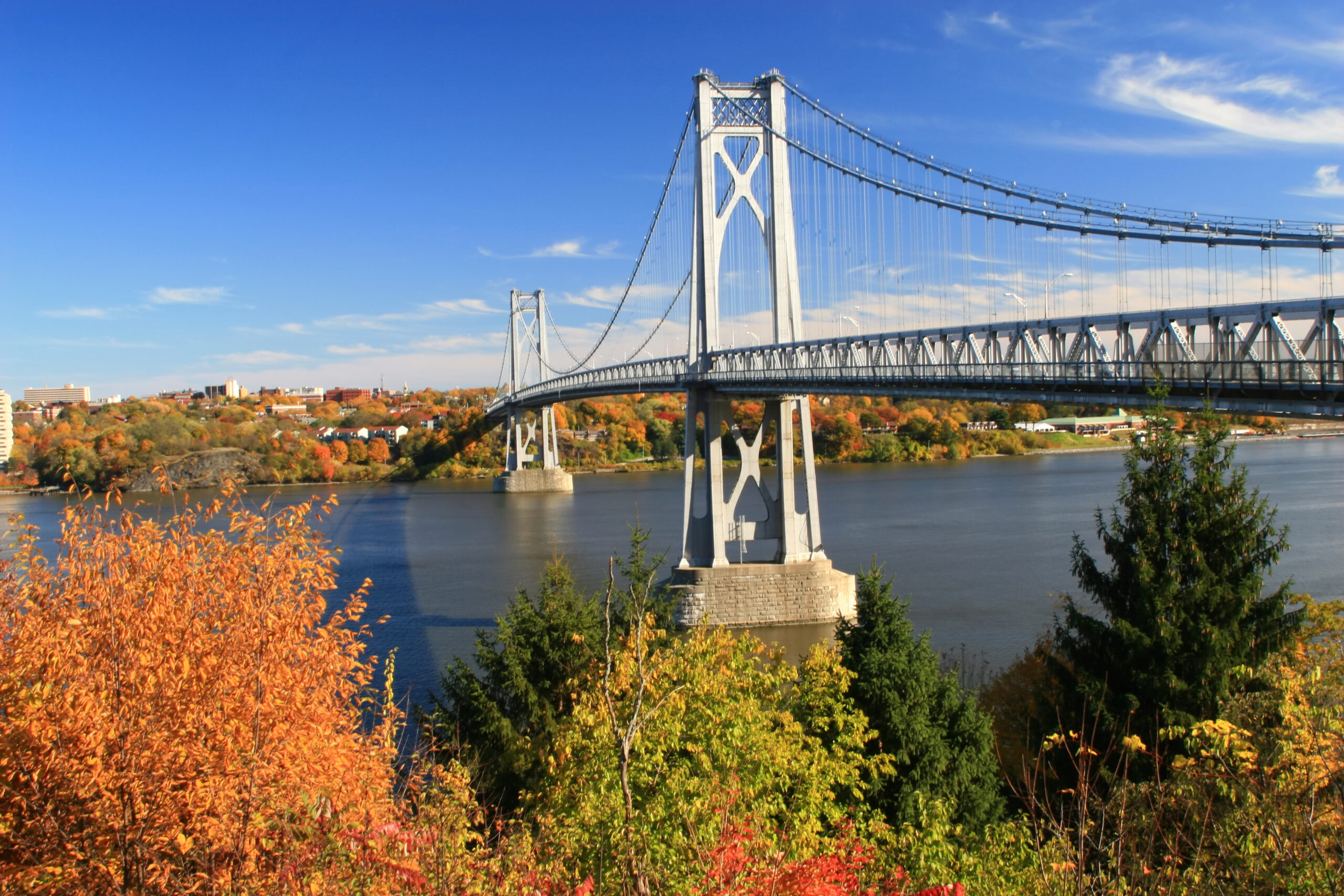If science fiction has taught us anything, by 2024, we should have been cruising around in flying cars. Yet here we are, still relying on the same roads and bridges our ancestors built. While the dream of flying cars is still out of reach, one reality we must face is the aging infrastructure beneath our wheels—especially America’s bridges.
Despite the lack of flying cars being deeply disappointing from a sci-fi nerd standpoint, the roads and bridges of our ancestors are wishing for a lighter load. But, let’s talk about those bridges. The country has over 617,000 bridges, and a significant portion of them are nearing or exceeding their design life. According to the American Society of Civil Engineers: As of 2021, more than 40% of U.S. bridges are at least 50 years old, and as of the most recent report, about 7.5% are considered structurally deficient.[1] These aging structures pose risks—not only to public safety but also to industries like insurance, which must adapt to the growing financial and liability concerns associated with failing infrastructure.
The state of bridges
The ASCE’s most recent infrastructure report card gave U.S. bridges a grade of C.[2] While a C may have been good enough for me in high school Spanish, in the present case, a C grade is a reflection of the advanced age and strain many of bridges are under. Most bridges are built to last around 50 years, but with significant portions of the nation’s infrastructure dating back to the mid-20th century, maintenance has not kept pace with the growing wear and tear.
Exacerbating the issue is an increase in extreme weather events. A recent article from the New York Times[3] highlighted the impact that climate change and extreme weather events are having on the health of America’s bridges. A study, cited in that article, found that extreme weather and increasing temperatures could lead to severe structural deterioration of a quarter of the nation’s bridges to the point of collapse.[4]
As America’s bridges continue to age, some at an accelerated pace, significant insurance implications exist.
The insurance implications of aging bridges
With bridges deteriorating at an alarming rate, the risks go beyond just structural safety—they extend to industries like insurance, which must adapt to new financial and liability challenges posed by these aging structures.
Bridge collapses or failures can lead to catastrophic damage, from loss of life to damage to vehicles, businesses, and property in the surrounding area. When such incidents occur, the legal and financial liabilities can be enormous. Insurers that cover municipalities or businesses involved in infrastructure projects may face large claims resulting from accidents tied to poorly maintained bridges.
For example, the collapse of the Fern Hollow Bridge in Pittsburgh in 2022. The National Transportation Safety Board investigation revealed that the collapse was primarily due to corrosion and structural deterioration of the bridge’s legs.[5] Over time, water and debris accumulated in the drainage systems, preventing the protective rust layer from forming on the steel. This led to extensive section loss, and ultimately, the failure of a critical structural element. The replacement of Pittsburgh’s Fern Hollow Bridge cost approximately $25.3 million.[6]
Another example of a bridge collapse occurred in June of 2023, when a bridge over the Yellowstone River in Montana collapsed, sending a freight train carrying hazardous materials, including hot asphalt and molten sulfur, into the river.[7] The collapse caused significant environmental concerns, disruptions to water services and internet connectivity. Experts believe that years of heavy river flow and erosion may have weakened the bridge structure, contributing to its failure. The cost of repairing the bridge still is being assessed, but initial estimates suggest that the overall damages—including the environmental cleanup and infrastructure restoration—are significant.
In a less extreme case, excessive heat caused New York City’s Third Avenue Bridge to become stuck in an open position for hours. While there were no long-lasting impacts, the closure impacted commerce in one of the commercial capitals of the world while ruining the day of thousands of New Yorkers.[8]
Bridges are a crucial part of the national transportation network, and their failure can have a cascading impact on nearby properties and businesses. Businesses that rely on transportation networks—particularly those near major waterways or highways—may face disruptions when bridges close for repair or collapse. These disruptions can affect revenue and productivity, leading to potential claims for business interruption or property damage.
When bridges fail, the legal and financial ramifications can be extensive. Municipal liability policies may be triggered, covering the costs of lawsuits, while property insurers may face claims for damage to nearby homes and businesses. In cases like the Yellowstone River collapse, environmental cleanup and business interruptions add additional layers of complexity for insurers. Property/casualty insurers may need to adjust premiums or policies to account for the higher risks posed by aging infrastructure. Businesses located near vulnerable bridges may face increased insurance costs due to their proximity to potential risks.
The youth movement
Given the economic, safety, and insurance concerns tied to aging bridges, it’s clear that steps must be taken to mitigate risks. The good news is that multiple strategies can help tackle the problem.
The most obvious solution is to increase funding for repairs and maintenance. The Infrastructure Investment and Jobs Act allocates significant funding for bridge repair through various programs. Specifically, the act earmarked $110 billion for major transportation projects like the repair and construction of roads and bridges. Included in the funding is creation of a Bridge Investment Program. The BIP is designed to provide competitive grants to improve bridge conditions and enhance safety and efficiency. From 2022 to 2026, the BIP is set to receive $2.5 billion in appropriations.
The IIJA also establishes the Promoting Resilient Operations for Transformative, Efficient, and Cost-Saving Transportation Program. The PROTECT Program aims to enhance the resilience of the U.S. transportation infrastructure—particularly in the face of climate change and extreme weather events. The PROTECT Program is designed to help states improve the resilience of their transportation infrastructure, including bridges, against natural hazards such as flooding, sea-level rise, and extreme weather. It supports projects that strengthen existing infrastructure to withstand these challenges. The program has allocated over $200 million for resilience projects in 21 states, which includes specific improvements to bridges.
While the IIJA provides a critical influx of funding, it’s important to note that the process of upgrading or replacing bridges is time-consuming and costly. The BIP and PROTECT programs are steps in the right direction, but ongoing public-private partnerships and further investment will be crucial to ensuring sustainable, long-term solutions.
Insuring future infrastructure
The IIJA represents a substantial investment in bridge infrastructure, with a focus on improving safety and reliability across the nation’s bridges. The IIJA investment in bridge infrastructure not only serves to better protect citizens as they travel, but it may serve as a boon to the insurance industry.
First and foremost, better-built bridges keep people safe. Modern construction materials and methods can extend the lifespan of bridges and make them more resilient to environmental and structural stresses. For example, high-performance concrete and steel can reduce the wear and tear bridges experience significantly. Furthermore, innovations like smart infrastructure—bridges equipped with sensors that monitor structural health in real-time—can help identify potential failures before they happen, reducing both risk and insurance costs.
As smart technology becomes more integrated into bridge maintenance, insurers may see lower risks, resulting in reduced premiums. These real-time monitoring systems also could lead to new insurance products tailored to infrastructure projects equipped with advanced monitoring capabilities.
Beyond the reduced risk of a loss, increased investment in bridge infrastructure means increased investment in construction and engineering projects. An increase in construction and engineering means a corresponding increase in the insurance needed to protect the people and materials used in those projects.
A strong foundation for the future
While we may not have the flying cars that sci-fi promised, the reality is that we still rely heavily on the aging bridges that connect our communities and support our economy.
As these structures continue to deteriorate, the risks they pose—both in terms of public safety and insurance liability—are too great to ignore. However, with renewed investment through initiatives like the IIJA and the integration of cutting-edge technologies, we have the tools to future-proof our infrastructure. In doing so, we might not be soaring above the roads just yet, but we can ensure that the bridges beneath us remain strong, safe, and ready for whatever the future holds.
As we repair and innovate, the insurance industry will play a critical role in adapting to this evolving landscape, ensuring that, while our wheels stay on the ground, our infrastructure is elevated to new heights.
The series …
PIA infrastructure series: Introduction
Infrastructure series: Bridge the gap: We need solid structures in a world without flying cars
Infrastructure series: Why broadband internet matters more than ever
Infrastructure series: Aviation initiatives are taking flight
Infrastructure series: Transportation spending and its impact on insurance
Infrastructure series: Clean water initiatives and property insurance— the IIJA’s impact
[1] https://infrastructurereportcard.org/cat-item/bridges-infrastructure/
[2] Ibid.
[3] https://www.nytimes.com/2024/09/02/climate/climate-change-bridges.html
[4] https://journals.plos.org/plosone/article?id=10.1371/journal.pone.0223307
[5] https://www.ntsb.gov/news/press-releases/Pages/NR20240221.aspx
[6] https://www.americanprogress.org/article/pennsylvania-fern-hollow-bridge-repair-project/
[7] https://fortune.com/2023/06/25/freight-train-montana-bridge-collapse-yellowstone-river-asphalt-sulfur/
[8] https://abc7ny.com/post/avenue-bridge-connecting-bronx-manhattan-stuck-open-position/15043550/

Bradford J. Lachut, Esq.
Bradford J. Lachut, Esq., joined PIA as government affairs counsel for the Government & Industry Affairs Department in 2012 and then, after a four-month leave, he returned to the association in 2018 as director of government & industry affairs responsible for all legal, government relations and insurance industry liaison programs for the five state associations. Prior to PIA, Brad worked as an attorney for Steven J. Baum PC, in Amherst, and as an associate attorney for the law office of James Morris in Buffalo. He also spent time serving as senior manager of government affairs as the Buffalo Niagara Partnership, a chamber of commerce serving the Buffalo, N.Y., region, his hometown. He received his juris doctorate from Buffalo Law School and his Bachelor of Science degree in Government and Politics from Utica College, Utica, N.Y. Brad is an active Mason and Shriner.





